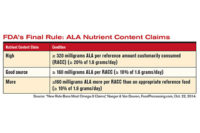When Given the Choice: Choose Omega-3s
When faced with the option to select an omega-3-enhanced food or beverage, more and more consumers are choosing the omega-3 product. Since its debut earlier this year, Sara Lee sliced sandwich bread made with omega-3 has become a staple in my household.

 When faced with the option to select an omega-3-enhanced food or beverage, more and more consumers are choosing the omega-3 product. Since its debut earlier this year, Sara Lee sliced sandwich bread made with omega-3 has become a staple in my household. And when Quiznos and Subway are equally convenient, Quiznos wins. Since June, the quick-service chain offers 16 salad dressings and sandwich toppings enhanced with the omega-3 docosahexaenoic acid (DHA).
When faced with the option to select an omega-3-enhanced food or beverage, more and more consumers are choosing the omega-3 product. Since its debut earlier this year, Sara Lee sliced sandwich bread made with omega-3 has become a staple in my household. And when Quiznos and Subway are equally convenient, Quiznos wins. Since June, the quick-service chain offers 16 salad dressings and sandwich toppings enhanced with the omega-3 docosahexaenoic acid (DHA).
DHA, as well as eicosapentaenoic acid (EPA), are long-chain omega-3 fatty acids that serve as primary building block for the brain and the eyes and support brain, eye and cardiovascular health throughout life. They are either derived from fish or algae, and are the only omega-3s that FDA allows for a qualified health claim.
A third form of omega-3, alpha linolenic acid (ALA), is derived from plants. It is converted by the body in varying rates to DHA and EPA.
There is a large and growing body of scientific evidence demonstrating that people of all ages, from infants to aging adults, benefit from an adequate supply of omega-3 fatty acids in the diet. Scientific reviews highlight the benefits of omega-3s, yet despite its importance, Americans have among the lowest dietary intakes of omega-3s in the world.
But Americans are catching on, thanks to companies such as Sara Lee and Quiznos…as well as myriad dairy processors who are enriching everything from fluid milk to yogurt to frozen desserts with omega-3s. And the omega-3 ingredient business is still in its infancy, with great potential for double-digit growth.
New analysis from Frost & Sullivan, London, finds that the market earned revenues of $323.0 million in 2008 and estimates this to reach $525.6 million in 2013. Manufacturers who recognize the link between consumer awareness and product marketability are branding their ingredients on consumer food and beverage products. Meanwhile, the Global Organization of EPA & DHA Omega-3, an industry organization, has funded Purdue University, to establish the Omega-3 Learning Consortium for Health and Medicine to provide credible information about omega-3 fatty acids to consumers, health professionals and the media.
“Industry associations have been successfully formed to protect their interests and voice their opinions to government agencies charged with regulating food ingredients,” says Frost & Sullivan Research Consultant Christopher Shanahan. “These associations play a critical role in addressing crucial legislative challenges facing the industry and in providing opportunities that benefit the overall growth of the market.”
The projected 10% compound annual growth rate from 2008 to 2013 in the marine and algae oil omega-3 ingredient market is likely to jumpstart key condition-specific health markets such as cognitive health, joint health and immune health. However, participants have a lot of ground to cover with regard to awareness and acceptance. They have been greatly assisted in their endeavors by positive media coverage. They have also benefited from an aging population that is more predisposed to chronic illness such as cardiac disorders, strokes, osteoporosis and cancers.
“A larger number of consumers consider food products an alternative means to prevent many diseases and adverse health conditions such as cardiovascular disease,” says Shanahan. “The demand for omega-3 ingredients is directly related to the escalating incidence of cardiovascular disease in developed countries and it significantly hikes the unit consumption.”
Exhibitors at this year’s IFT Annual Meeting + Food Expo put omega-3s in the spotlight. Here’s a sampling of some fortification options available to dairy processors.
A supplier offering a DHA-EPA blend ingredient touts the fact that it is derived from sustainable marine species. The ingredient is available as an oil and as an encapsulated powder, which would likely be the preferred form for dairy processors. The supplier sampled its ingredient in a Chicago-style pizza where the omega-3 was delivered in both the crust and the cheese.
A different supplier offers a highly concentrated fish oil emulsion with superior stability, which the company claims prevents the formation of any fishy off notes. This increases the applicability of EPA and DHA in delicate food systems such as milk.
Another fish oil ingredient supplier sampled its ingredient in an organic whole milk that was also enhanced with vitamins D and E, two vitamins that are recognized as being deficient in the American diet. The prototype is positioned as a “head start” milk to help kids develop a healthy heart and mind. The omega-3 PUFA blend comes in oil, powder and emulsion forms…an option for every application.
Using patented microencapsulated technology, another supplier uses tuna oil to offer a powder or oil omega-3 ingredient. The technology is said to protect against oxidation and provide a taste barrier to any fishy off notes.
A whey protein supplier offers a protein enrichment ingredient for beverages that is also enhanced with ALA, DHA and EPA.
A soy protein supplier now offers a soybean oil ingredient that contains 20% stearidonic (SDA) in mixed triglyceride form. The company claims that SDA converts to EPA in the body more efficiently than ALA. Derived from soybeans, this vegetarian ingredient is void of any fishy off flavors.
The sole U.S. supplier of algal-derived DHA announced the commercialization of a new algal EPA, which will essentially be fish-free fish oil. This will be a completely sustainable, vegetarian source of algal EPA and DHA. The company’s DHA is the only DHA allowed in U.S. infant formula and one can say is responsible for educating parents about the benefits of feeding children omega-3-enhanced foods.
The natural transition from infant formula to milk makes dairy the leading delivery vehicle for these critical fatty acids. When contemplating functional ingredients to enhance your company’s dairy products, choose omega-3s.

Source: Vitiva

Source: Mountain High Yoghurt
DHA, as well as eicosapentaenoic acid (EPA), are long-chain omega-3 fatty acids that serve as primary building block for the brain and the eyes and support brain, eye and cardiovascular health throughout life. They are either derived from fish or algae, and are the only omega-3s that FDA allows for a qualified health claim.
A third form of omega-3, alpha linolenic acid (ALA), is derived from plants. It is converted by the body in varying rates to DHA and EPA.
There is a large and growing body of scientific evidence demonstrating that people of all ages, from infants to aging adults, benefit from an adequate supply of omega-3 fatty acids in the diet. Scientific reviews highlight the benefits of omega-3s, yet despite its importance, Americans have among the lowest dietary intakes of omega-3s in the world.
But Americans are catching on, thanks to companies such as Sara Lee and Quiznos…as well as myriad dairy processors who are enriching everything from fluid milk to yogurt to frozen desserts with omega-3s. And the omega-3 ingredient business is still in its infancy, with great potential for double-digit growth.
New analysis from Frost & Sullivan, London, finds that the market earned revenues of $323.0 million in 2008 and estimates this to reach $525.6 million in 2013. Manufacturers who recognize the link between consumer awareness and product marketability are branding their ingredients on consumer food and beverage products. Meanwhile, the Global Organization of EPA & DHA Omega-3, an industry organization, has funded Purdue University, to establish the Omega-3 Learning Consortium for Health and Medicine to provide credible information about omega-3 fatty acids to consumers, health professionals and the media.
“Industry associations have been successfully formed to protect their interests and voice their opinions to government agencies charged with regulating food ingredients,” says Frost & Sullivan Research Consultant Christopher Shanahan. “These associations play a critical role in addressing crucial legislative challenges facing the industry and in providing opportunities that benefit the overall growth of the market.”
The projected 10% compound annual growth rate from 2008 to 2013 in the marine and algae oil omega-3 ingredient market is likely to jumpstart key condition-specific health markets such as cognitive health, joint health and immune health. However, participants have a lot of ground to cover with regard to awareness and acceptance. They have been greatly assisted in their endeavors by positive media coverage. They have also benefited from an aging population that is more predisposed to chronic illness such as cardiac disorders, strokes, osteoporosis and cancers.
“A larger number of consumers consider food products an alternative means to prevent many diseases and adverse health conditions such as cardiovascular disease,” says Shanahan. “The demand for omega-3 ingredients is directly related to the escalating incidence of cardiovascular disease in developed countries and it significantly hikes the unit consumption.”
Exhibitors at this year’s IFT Annual Meeting + Food Expo put omega-3s in the spotlight. Here’s a sampling of some fortification options available to dairy processors.
A supplier offering a DHA-EPA blend ingredient touts the fact that it is derived from sustainable marine species. The ingredient is available as an oil and as an encapsulated powder, which would likely be the preferred form for dairy processors. The supplier sampled its ingredient in a Chicago-style pizza where the omega-3 was delivered in both the crust and the cheese.
A different supplier offers a highly concentrated fish oil emulsion with superior stability, which the company claims prevents the formation of any fishy off notes. This increases the applicability of EPA and DHA in delicate food systems such as milk.
Another fish oil ingredient supplier sampled its ingredient in an organic whole milk that was also enhanced with vitamins D and E, two vitamins that are recognized as being deficient in the American diet. The prototype is positioned as a “head start” milk to help kids develop a healthy heart and mind. The omega-3 PUFA blend comes in oil, powder and emulsion forms…an option for every application.
Using patented microencapsulated technology, another supplier uses tuna oil to offer a powder or oil omega-3 ingredient. The technology is said to protect against oxidation and provide a taste barrier to any fishy off notes.
A whey protein supplier offers a protein enrichment ingredient for beverages that is also enhanced with ALA, DHA and EPA.
A soy protein supplier now offers a soybean oil ingredient that contains 20% stearidonic (SDA) in mixed triglyceride form. The company claims that SDA converts to EPA in the body more efficiently than ALA. Derived from soybeans, this vegetarian ingredient is void of any fishy off flavors.
The sole U.S. supplier of algal-derived DHA announced the commercialization of a new algal EPA, which will essentially be fish-free fish oil. This will be a completely sustainable, vegetarian source of algal EPA and DHA. The company’s DHA is the only DHA allowed in U.S. infant formula and one can say is responsible for educating parents about the benefits of feeding children omega-3-enhanced foods.
The natural transition from infant formula to milk makes dairy the leading delivery vehicle for these critical fatty acids. When contemplating functional ingredients to enhance your company’s dairy products, choose omega-3s.
Looking for a reprint of this article?
From high-res PDFs to custom plaques, order your copy today!






